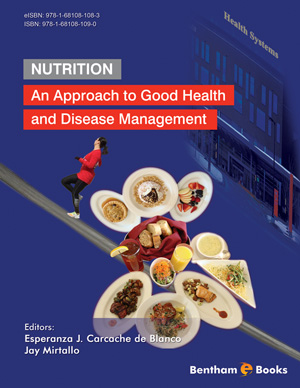Preface
Page: iii-iii (1)
Author: Esperanza Carcache de Blanco and Jay Mirtallo
DOI: 10.2174/9781681081083116010002
List of Contributors
Page: v-v (1)
Author: Esperanza Carcache de Blanco and Jay Mirtallo
DOI: 10.2174/9781681081083116010003
Background: Nutrition in Health and Disease
Page: 3-20 (18)
Author: Esperanza J. Carcache de Blanco and Jay Mirtallo
DOI: 10.2174/9781681081083116010004
PDF Price: $15
Abstract
Nutrition is a key player in the well-being of healthy individuals. Nutritional models have been designed over decades in an attempt to improve dietary patterns. In the last decades the government has been involved in the monitoring of the guidelines. Particularly, USDA has participated in the revision of nutritional models based on better understanding of nutritional needs. Hence, this chapter provides an overview on nutritional models and its correlation and impact on nutrition in health and disease management.
Food Regulations in the United States
Page: 21-60 (40)
Author: Melvin A. Pascall and Ken Lee
DOI: 10.2174/9781681081083116010005
PDF Price: $15
Abstract
Food laws and regulations within the United States are essential to food safety, commerce and improved national health. Understanding the differences between foods, drugs and dietary supplements is important for both regulatory and national health reasons. If these commodities are not defined properly and label claims about them are not in keeping with both good science and prevailing legislation, the packaged products could be in violation of the related laws or regulations. There are thirteen federal agencies that are associated with food regulation and safety in some manner. Of great interest across several agencies are specific regulations relating to food labeling. There is mandatory information that must be on all Food and Drug Administration (FDA) and United States Department of Agriculture (USDA) regulated labels, and there are new allowable label claims to help consumers understand the connection between food and health. This work focuses on special food ingredients and additives that have high public or scientific interest, with reference to selected categories of ingredients. These include direct, secondary direct and indirect ingredients, generally recognized as safe (GRAS) substances and color additives. The chapter discusses the rationale behind the Infant Formula Act and provides an overview of FDA and USDA inspection strategies and enforcement actions.
Macronutrients
Page: 61-100 (40)
Author: Esperanza J. Carcache de Blanco
DOI: 10.2174/9781681081083116010006
PDF Price: $15
Abstract
The human body is a complex system that requires energy to function properly. The most common sources of energy for the human body and that are called nutrients come from plant and animal origin. The nutrients include carbohydrates, proteins, and lipids. This chapter focuses on the three major groups of nutrients that the human body uses to obtain energy in order to perform its functions.
Macronutrients Nutritional Requirement Applications
Page: 101-119 (19)
Author: Esperanza J. Carcache de Blanco and Jay Mirtallo
DOI: 10.2174/9781681081083116010007
PDF Price: $15
Abstract
Macronutrients are important components of human diet. The three most important macronutrients include carbohydrates, lipids, and proteins. Adequate consumption of the three major macronutrients has been associated with a good diet and good health. Analysis on the use of these macronutrients as part of the diet and the application of the concepts learned in chapter 3 will be presented in this chapter.
Micronutrients
Page: 121-180 (60)
Author: Roshamur C. Forestrania, Michelle OgavaIgual and Esperanza J. Carcache de Blanco
DOI: 10.2174/9781681081083116010008
PDF Price: $15
Abstract
The human body is a complex system that requires multiple nutrients to function properly. Most of the micronutrient components are not energy-yielding substances and include vitamins, minerals, and water. This chapter focuses on studying the importance of these micronutrients as key components in a balanced and healthy diet. They are indispensable in good health and the human body uses them to perform its functions.
Micronutrients: Nutritional Requirement Applications
Page: 181-200 (20)
Author: Nicole Eggers, Preston Manwill, Jay Mirtallo and Esperanza J. Carcache de Blanco
DOI: 10.2174/9781681081083116010009
PDF Price: $15
Abstract
Micronutrients are required in minor quantities by the human body, but are important components of human diet. The most important groups of micronutrients include vitamins, minerals, and water. Adequate intake of these micronutrients has been associated with a good diet and good health. Analysis of the use of these micronutrients as part of the diet and the application of the concepts learned in chapter five will be presented and discussed in this chapter.
Phytochemicals in Nutrition and Health
Page: 201-243 (43)
Author: Nicole A. Eggers and Esperanza J. Carcache de Blanco
DOI: 10.2174/9781681081083116010010
PDF Price: $15
Abstract
Some phytochemicals, or chemical compounds produced by or present in plants, may be nutritious for human consumption. Phytochemicals are not essential nutrients for humans, but they may contribute to preventing or treating diseases such as cancer, diabetes, diseases of the eye, and cardiovascular disease. In this chapter, some of the most important phytochemicals for human health and nutrition are detailed, along with their mechanisms of action, chemical structures, and specific health benefits. These health-promoting phytochemicals are present in familiar plant sources of fruits, vegetables, and legumes. The carotenoids in tomatoes, for example, are studied for anticancer effects and reduced risk of cardiovascular diseases. The proanthocyanidins in cranberries can prevent or treat urinary tract infections. The isoflavonoids in soybeans mimic hormones, which contribute to the possible effectiveness in some breast cancers. The sulfur-containing phytochemicals in broccoli and Brussels sprouts have potential anticancer effects. A few sulfur-containing compounds in garlic are very good antibacterial agents. The study of chemical compounds present in common edible plants, allows students to correlate nutrition to disease prevention or treatment by functional foods; perhaps this chapter even facilitates thinking about foods as drugs.
Influence of Socio-economic Status and Culture in Diet and Nutrition
Page: 245-268 (24)
Author: Esperanza J. Carcache de Blanco and Jay Mirtallo
DOI: 10.2174/9781681081083116010011
PDF Price: $15
Abstract
Dietary components are corner stones in having a good and balanced nutrition. Nutrition is directly correlated to health; hence, having good dietary habits will highly contribute to good health. However, there are different factors that influence good dietary patterns including socioeconomic status, income, and culture. This chapter will discuss the impact of these factors on nutrition and diet of different groups.
Factors Contributing to Health and Disease
Page: 269-290 (22)
Author: Jay M. Mirtallo and Esperanza J. Carcache de Blanco
DOI: 10.2174/9781681081083116010012
PDF Price: $15
Abstract
There are many aspects of the American diet that should be improved in order to promote health and prevent disease. The United States Departments of Agriculture and Health and Human Services are responsible for developing and updating guides to educate the public and professionals on nutritional health. The current guide: Dietary Guidelines for Americans, 2010 provides a wealth of ideas in simple, actionable health messages to improve the diet. This chapter reviews many of these principles for good nutrition health in addition to dietary reference intakes (DRI) important to assess the adequacy of specific nutrients in the diet as well as activity, a lifestyle that facilitates nutritional health.
The Role of Nutrition in Disease Management
Page: 291-341 (51)
Author: Jay M. Mirtallo, Nicole A. Eggers and Esperanza J. Carcache de Blanco
DOI: 10.2174/9781681081083116010013
PDF Price: $15
Abstract
There are many nutrition and lifestyle actions that Americans should consider that will influence the risk of developing disease. Cardiovascular disease, diabetes, osteoporosis and cancer have many risk factors that are both modifiable and non-modifiable. This chapter reviews these diseases and nutritional strategies and lifestyle changes that are useful in reducing the risk for developing disease. Since disease is frequently associated with malnutrition it is essential for health professionals to be able to screen for the risk of malnutrition and understand the criteria for its diagnosis.
Glossary
Page: 343-354 (12)
Author: Esperanza Carcache de Blanco and Jay Mirtallo
DOI: 10.2174/9781681081083116010014
Subject Index
Page: 355-357 (3)
Author: Esperanza Carcache de Blanco and Jay Mirtallo
DOI: 10.2174/9781681081083116010015
Introduction
This book summarizes key information required for planning and implementing a healthy diet for patients based on sound nutritional concepts. Readers will find information on the background of nutrition in disease management and nutritional regulations in the USA. The book also describes macro- and micronutrients (including minerals and vitamins) and the applications of relevant nutritional concepts to real-life situations, using well-designed simulated clinical scenarios. Additionally, factors contributing to disease as well as the link between socio-economic status, culture and nutrition are discussed. This book should serve as useful handbook for nutritionists and health care providers and medical or pharmacology students taking courses in nutritional sciences.



















